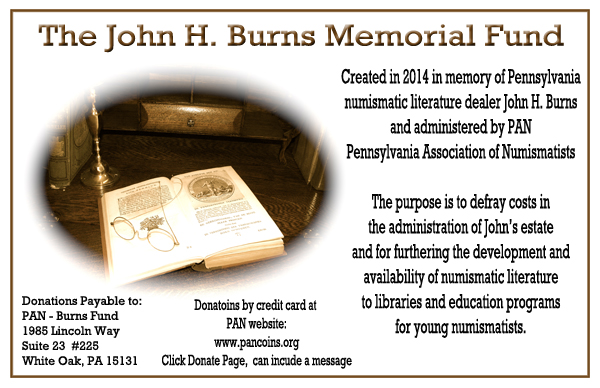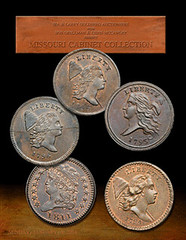
PREV ARTICLE
NEXT ARTICLE
FULL ISSUE
PREV FULL ISSUE
BILL ECKBERG'S MISSOURI CABINET DIARY
It's a tradition among members of the Early American Coppers Society (EAC) to publish a diary of their trips to major conventions and auctions. Bill Eckberg continued that tradition this week by publishing an email blog about his trip to California for the Missouri Cabinet sale. Here are some excerpts.
-Editor
Part I (January 24, 2014, 9:47 PM)
Part III (January 26, 2014, 2:17 AM)
I finally meet Lyle Engleson, the Goldbergs’ superb photographer. He proves to be the same, nice guy he was by email when we were working on the grading guide. There are a bunch of people that have rarely been seen at EAC in recent years: Bland, Bobbie, Hanson, Coleman, etc. They’ve come for the big show, and I’m sure they won’t be disappointed. I chat at length with Tett's wife, Marilyn and with Pat Husak.
Part IV (January 26, 2014, 10:27 AM)
Tett was self-effacing as always, Marilyn was charming as always, and everyone else seemed to be in a great mood. The food was plentiful as were the beer, wine and soft drinks, but I made it a point not to take seconds of anything other than the very nice mini-Kobe beef tacos, of which I did have two. The reception was in a courtyard, and there were several ornamental gas heaters that I thought were unnecessary. There also were two different posters that everyone was asked to sign. One was to be sold as the final lot in the MoCab sale with proceeds to EAC. The other as a gift to a collector whose name I won’t divulge, as he may not know this is being done.
Part V (January 26, 2014, 11:40 PM)
The first few lots go pretty much as expected, though I think the gorgeous 1793 C1 is a bargain to the buyer at $330K. I’ve guessed that lot 6, the PCGS 66 C4 COULD top $1M. It hammers at $800k, or 92% of that, with the juice. The 1794s generally go for good, but not spectacular money, though the C7 does hammer at $1M - the first half cent ever to sell (publicly, at least) for over $1M. The C9 goes for more than 4x the estimate, but the UNC 1795 C-5 with the planchet flaw hammers for less than half the estimate. It’s clear at this point that there is a pattern developing. The big spenders are set registry folks, which is what most of us expected, unfortunately. The 1796 no-pole is another lot that many of us thought might fetch $1M, but it hammers at $775K, only marginally above estimate. The 1797 C2 sells for a strong $350K, about 7x estimate, and the finest-known low-head fetches $150K, or 5x estimate. Tett’s favorite coin (and my favorite of his collection), the low head struck over a 1798 large cent in 1800, brings a strong $77,500. Then it gets interesting. The RB 1800, a coin VERY much like the one Susan gave me for a wedding present and which now graces a Nebraska collection, goes for a whopping $40K! But a bigger shocker is that a RB 1803 C3 (R1!) brings a $250K hammer!!! A lot of us are looking around going “huh?” Draped Bust variety collecting is alive and well, as most lots go well over their estimates, but not obscenely so, though a PCGS 66 C8 Spiked Chin hammers for nearly 6x the estimate. The red C13 brings a strong $65K, and we break for a very nice lunch. It gets really weird when we come back. The RB 1805 C4 seems to be the harbinger, bringing nearly $100K on a $20K estimate. The very common, even in UNC, 1806 C1 in 66RB brings an astounding $120K. A typical LDS 1807 with nice color surprised me at $62.5K, whereas the by far finest known 1808 C1 hammers at $160K, just above the estimate. The 1808 C2 in UNC goes for $420K. By now, people are starting to make funny faces and look around. R1 varieties of 1809 all hammer for several tens of thousands of dollars. A very nice 1810 hammers for $95K against a $12.5K estimate. Then comes the prooflike RB 1811 C1. It becomes the second million-dollar coin, hammering at $975K or $1.21M with the juice. Prices continue to be strong through the rest of the Classic Heads, but mostly for the pop tops. A hoard coin, 1828 C3 goes for $22K! Can you say Set Registry collector? The sale of 230 lots has taken just about 6 1/2 hours. A lot of it went slowly, because the book bids were low, so the coins started at prices far less than they eventually brought. Many of us, not least myself, came because we wanted to honor Tett, a gentleman of the first order who has been a wonderful mentor to so many of us. Every time I have ever asked him for information, he gave more than I asked. Years ago, I asked him for some information about his error set, and he sent me many pages of handwritten material, describing every significant error coin he had. That led to two articles in P-W, and for that and MANY other kindnesses, I am forever grateful to him and proud that I was able to score a couple of the error coins about what I wrote. But it’s bittersweet seeing these coins sold. There is no chance that many of the new owners will share them with the rest of EAC - if they are even members - the way Tett always has. We will miss the coins, but I know Tett will continue to come to EAC shows to spend the time with his friends. And he has MANY friends. As many of you know, this collection was a collaboration between Tett and Eric Newman. Most, if not all, of Eric’s coins had not sold publicly for a century. That and their freshness may account for some of the huge prices.

Wayne Homren, Editor The Numismatic Bibliomania Society is a non-profit organization promoting numismatic literature. See our web site at coinbooks.org. To submit items for publication in The E-Sylum, write to the Editor at this address: whomren@gmail.com To subscribe go to: https://my.binhost.com/lists/listinfo/esylum All Rights Reserved. NBS Home Page Contact the NBS webmaster 
|
